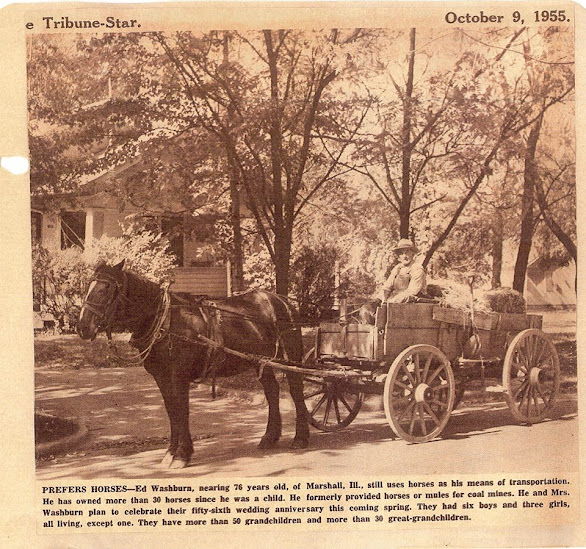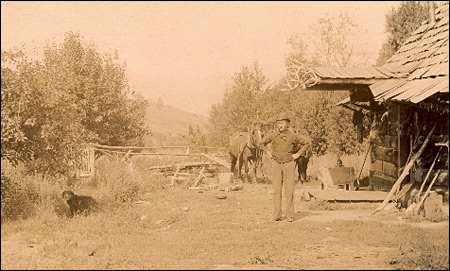"Oops!" When I read this week's prompt for the 52 Ancestors in 52 Weeks challenge, one story immediately came to mind. This is the story that my boys, who claim no interest in our family history, ask for me to tell most often.
Our illustrious - or not! - Civil War ancestor, George Samuel Sult.
George was born in the late fall of 1842, the first child of Jacob & Georgiana Sult, in Butler County, Ohio[1]. By 1860 several more children had joined the family and the Sults had moved a little further west, to Indiana[2].
George joined the Union Army 1 February 1862, in Indianapolis, Indiana, when he was 19 years old, enlisting as a private in Company K of the 52nd Indiana Infantry [3].
The company was on the move from nearly the moment that George joined. Here's a timeline of their movements [4]:
February 1, 1862: Regiment raised in Rushville & Indianapolis, Indiana
February 7, 1862: Left Rushville, Indiana for Fort Donelson, TN
February 12–16, 1862: Victory at the Battle of Fort Donelson
February 16, 1862 - April 18, 1862: Garrison at Fort Henry, TN
March 11, 1862: Action at Paris, TN with light casualties. Withdrew
April 18, 1862: Moved to Pittsburg Landing, TN in the aftermath of the Battle of Shiloh
April 29, 1862 - May 30, 1862: Advance on and sieged of the town of Corinth, TN as General Henry Halleck pursued confederate General P. G. T. Beauregard in retreat from Shiloh.
June 1, 1862 - July 21, 1862: March to Memphis, Tennessee, via Grand Junction, LaGrange, and Holly Springs
June 4, 1862: During the march to Memphis, Colonel James M Smith resigned and Lt. Colonel Edward H. Wolfe assumed command
July 22, 1862 - September 1, 1862: Duty at Memphis, TN
September 2, 1862: Action near Memphis, TN
September 17,1862: Durhamsville
September 30, 1862, to January 18, 1863: Garrison duty at Fort Pillow, Tennessee, and operations against guerrillas in Tennessee and Arkansas .
September 19–25, 1863: Expedition to Jackson, MS (as a detachment)
September 28, 1863 - October 5, 1863: Expedition to Covington, Durhamville, and Fort Randolph
The unit went on to serve until the end of the war, officially mustering out on 10 September 1865.
George Sult's time in the military was short though - OOPS! - in October 1862, just a few months after joining when he was stacking firewood in camp and gave himself a hernia [5]! His Civil War pension record is quite extensive and details the health struggles that he faced the rest of his life [6]. Many of his associates who wrote letters for his pension application described him as "a small yellow man."

On 25 November 1863 George married Mary Davis [7]. Sadly, Mary passed away just a few years later in September 1865 [8]. George then married Nancy Joslin 25 March 1869 [9]. They had four children - Theodore Wesley, Mary Etta, Rose Zella, and Ollie Belle [10]. Mary Etta is my great great grandmother.

George passed away 18 July 1893 in Sullivan County, Indiana [11]. He is buried in Center Ridge Cemetery with a military stone despite his "Oops!" moment that cut his military career short [12].
------------------------------------------------
[1] 1850 U.S. census, Cincinnati Ward 6, Hamilton, Ohio; Page: 163; Image: 168, George Sult; digital image, Ancestry.com (http://ancestry.com : accessed 27 January 2023), citing National Archives microfilm publication M432 roll 689.
[2] 1860 U.S. census, Spencer, Jennings, Indiana; Page: 269; Image: 271, George Sult; digital image, Ancestry.com (http://ancestry.com : accessed 27 January 2023), citing National Archives microfilm publication M653 roll 271 .
[3] U.S., Civil War Draft Registrations Records, 1863-1865; George Sult, digital image, Ancestry.com (http://ancestry.com : accessed 27 January 2023).
[4] U.S. Department of the Interior. (n.d.). Battle unit details. National Parks Service. Retrieved January 27, 2023, from https://www.nps.gov/civilwar/search-battle-units-detail.htm?battleUnitCode=UIN0052RI
[5] George Sult's pension
application; service of George Sult (Pvt., Co. K, 52d IN Infantry, Civil War); Case Files of
Approved Pension Applications ..., 1861–1934; Civil War and Later
Pension Files; Record Group 15: Records of the Department of Veterans
Affairs; National Archives, Washington, D.C.
[6] ibid.
[7] Indiana Marriage Collection, 1800-1941.
[8] George Sult's pension
application; service of George Sult (Pvt., Co. K, 52d IN Infantry, Civil War); Case Files of
Approved Pension Applications ..., 1861–1934; Civil War and Later
Pension Files; Record Group 15: Records of the Department of Veterans
Affairs; National Archives, Washington, D.C
[9] Grant County, Indiana, Marriage Records Volume I Book C (Sept 1831-June
1, Compiled by--Grant County Genealogy Club; Book: 4; Page: 209.
[10] George Sult's pension
application; service of George Sult (Pvt., Co. K, 52d IN Infantry, Civil War); Case Files of
Approved Pension Applications ..., 1861–1934; Civil War and Later
Pension Files; Record Group 15: Records of the Department of Veterans
Affairs; National Archives, Washington, D.C
[11]Find A Grave (http://www.findagrave.com : accessed 28 January 2023), memorial page 52952032 , PVT George Samuel Sult (1842 - 1893), created by "Wabash Valley Genealogy Society Cemetery Committee"; citing
Center Ridge Cemetery, Sullivan, Sullivan, Indiana, USA.
[12]Find A Grave (http://www.findagrave.com : accessed 28 January 2023), memorial page 52952032 , PVT George Samuel Sult (1842 - 1893), created by "Wabash Valley Genealogy Society Cemetery Committee"; citing
Center Ridge Cemetery, Sullivan, Sullivan, Indiana, USA.










